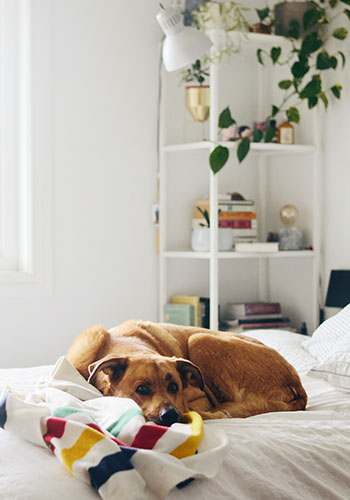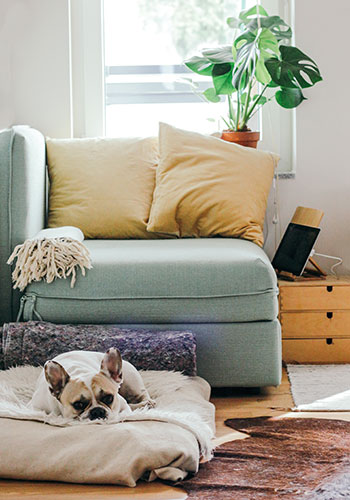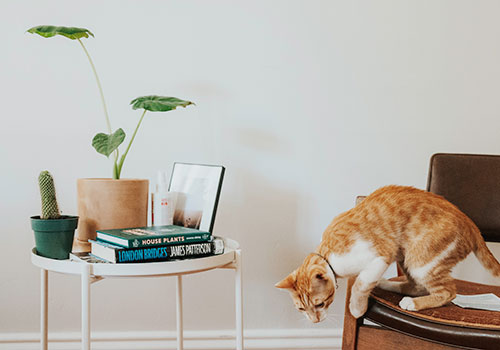Indoor Plants & Pets

You may have heard that indoor plants and pets don’t mix. Depending on what you’ve been reading, you might even have given up on the whole idea of house plants for fear of poisoning your fur-babies. While we definitely believe in being cautious about toxic plants, we’d like to offer a more optimistic perspective.
Keep in mind that we’re plant people here, so this isn’t meant to be medical advice. It’s always a good idea to consult your pet’s veterinarian if you have concerns about your pet’s health and safety around plants.
How toxic is it?
Yes, there are a few plants that can be seriously harmful or deadly if your pet eats them. However, the scary-sounding term “toxic” covers a huge spectrum. The vast majority of “toxic” plants won’t cause more than temporary skin irritation or perhaps a bit of an upset stomach for most pets. So when you see that alarming term, you might want to dig a little deeper.
If you’re wondering just how toxic a particular plant is, it’s a good idea to look up the symptoms associated with it. The ASPCA has an extensive list where you can see details for every plant.
When looking up a plant, make sure to use the official botanical name. This will be two words that might sound a little like a Harry Potter spell — a genus and species. Relying on common names can lead to confusion. Take two plants commonly called “lilies” for example: True lilies (Lilium species) can cause serious kidney damage and even death in cats, but Peruvian lilies (Alstroemeria species) will only cause a temporary stomach-ache or no symptoms at all.

It depends on your pet...
Keep in mind that plants have developed these toxins to discourage animals from eating them, and many animals instinctively get the message. They may try an experimental nibble, pick up on the plant’s toxicity, and then leave it alone. Other pets seem determined to keep eating toxic plants at any cost.
You know best whether your pets can be trusted to know what’s good for them. If you’re not sure, you could try exposing your pet to any new plants under close supervision at first.
Individual pets also have their own sensitivities and allergies, just like people. It’s possible that a plant that has no negative effects on most cats happens to make yours sick. It’s never a bad idea to be a little cautious when introducing a new plant to your pet’s environment, even if it’s on a list of non-toxic plants.

Non-Toxic Plants
If your pet insists on eating everything in sight, don’t get discouraged! There are plenty of wonderful plants that are generally safe for pets. A few of our most popular pet-safe indoor plants include African violet, Christmas cactus, boston fern, parlor palm, and spider plant.
It’s good to know that some cats can’t keep any greens down, yet seek them out anyway. So cats leaving you a nice little mess to clean after eating a plant listed as non-toxic doesn’t mean there’s any lasting harm done. It’s not known why cats eat greens even though they can have this effect, but it seems to be part of their natural behavior.

Protect your pet –– and your plants!
Whether you go with potentially toxic or completely non-toxic plants, you may still want to keep your leafy companions separated from your furry friends for the good of everyone involved. Pets can devour baby plants in short order.
One simple solution for indoor plants is to hang them from the ceiling, or place them on shelves that your pets can’t reach. That way, you can choose whatever plants you like without needing to worry.
If you choose to keep your non-toxic houseplants out of reach, you may want to grow or buy some greens specifically for your pets. Cat grass is one popular option that you can easily and inexpensively grow from seed.
If you do keep some of your plants within your pets’ reach, make sure your indoor gardening practices are non-toxic as well as your plants. Fertilizers and pest control products are important to consider. We can direct you to the safest plant-care options for your pets.
With a little consideration, pets and plants can happily coexist. We wish you and all of your companions — both four-pawed and green-leaved — all the best in your lives together.
